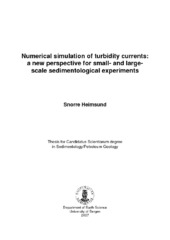| dc.description.abstract | Turbidity currents are a variety of subaqueous sediment-gravity flows, in which the suspension of sediment by water turbulence produces a water-sediment mixture that is denser than the ambient water and hence flows due to gravity along a topographic gradient. This type of sediment gravity flow is the most important mechanism for the dispersal and deposition of sand on deep-sea floors, as well as on the underwater slopes of many deltas and lakes. The hydrodynamics of turbidity currents are difficult to study in the natural environments, whereas laboratory experiments are limited to small-scale flows, time-consuming and not necessarily easier when it comes to the measuring of flow properties and establishing of the relationships between the turbulent flow structure and the transport and deposition of sediment. Mathematical models of turbidity current, integrated by computational fluid dynamics (CFD) and realized as numerical simulations, can be used to obviate these difficulties, and also to upscale laboratory datasets and to integrate the data from nature and experiments. The concept CFD refers to the numerical solution, by computational methods, of the governing equations describing fluid flow: the set of Navier-Stokes equations and the multi-phase fluid dynamics. CFD is widely used in the engineering branches of fluid mechanics, but is a relatively new numerical approach in the field of sedimentological research. In the present study, a three-dimensional model has been constructed by using the CFD software Flow-3D™ to simulate the flow of turbidity currents, including their internal hydraulic characteristics as well as sediment erosion and deposition. The Flow-3D™ model employs finite difference and finite volume methods and the turbidity current is being simulated by a range of physical models: 1) the turbulent flow structure is simulated by a turbulence model based on renormalization group theory that employs statistical methods to calculate turbulence quantities; 2) the water-sediment mixture is calculated by a drift-flux technique that describes the relative flow of two miscible fluids with different densities; 3) interactions between the continuous fluid and the dispersed mass particles are calculated by the particle model; and 4) the erosion and deposition of sediment are calculated by the sediment scour model. Simulations of small-scale turbidity currents imitating particular laboratory flows have shown that the results of Flow-3D™ are realistic and reliable. Similar series of flow simulations have been used further: 1) to display in a flow-parallel axial section the main hydraulic characteristics (bulk density, shear-strain rate, dynamic viscosity, velocity magnitude and its x-y-z components) of a channelconfined current; 2) to display of the shear stress, sediment concentration and velocity magnitude for several ‘probing stations’ in a channel-confined current expanding abruptly on an open-space flat floor; 3) to study the responses of the confined and unconfined parts of a current (in terms of its velocity magnitude, shear stress and sediment concentration) to changes in such principal controlling parameters as the channel slope angle, sediment grain size, floor roughness and initial sediment concentration; 4) to display sediment grain-size segregation in a current (using a flow run with polysized sediment suspension); 5) to display the velocity time series for a surge-type and a sustained turbidity current; and 6) to show the responses of turbidity current to various obstacles and to a hydraulic jump at the channel outlet. Two large-scale simulations of ‘real-life’ turbidity currents have been performed, one imitating modern flow events in the Soquel and Monterey canyons, offshore California, and another pertaining to the deposition of the Egga reservoir unit in the Ormen Lange field, Mid-Norway Continental Shelf. The present study has evaluated Flow-3D™ as a possible means of simulating hydrodynamic behaviour of turbidity currents. The comparison of numerical and flume data indicates that the CFDbased Flow-3D™ models can give realistic results and serve as an attractive alternative to laboratory flume experiments. The use of a CFD software, such as the Flow-3D™, has several great advantages: 1) it allows a much wider range of flow parameters to be determined and continuously monitored with a relatively high accuracy; 2) it permits the response and relative importance of the individual flow parameters to be assessed with respect to changes in the initial conditions; 3) it allows turbidity currents to be up-scaled to natural conditions; and 4) it provides an unprecedented insight in the detailed hydrodynamic aspects of turbidity current. The study indicates that our understanding of turbidites and their variability can be significantly improved by this type of experimental research. | en_US |
